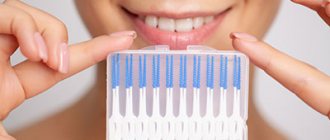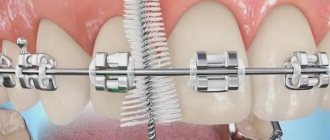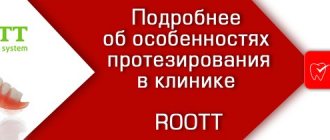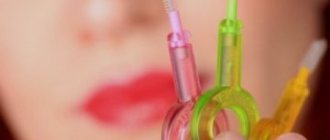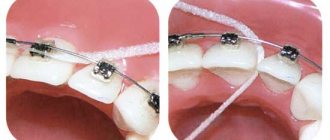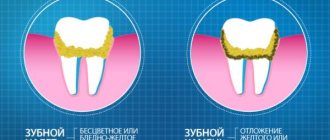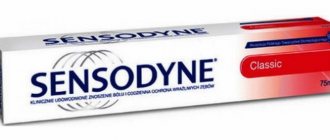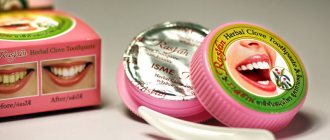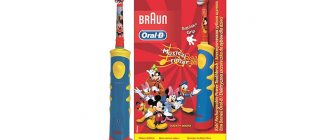For these purposes, various means are provided (special brushes, dental floss, irrigators, etc.).
And one of such effective devices is brushes for braces .
They are designed to clean the interdental space and braces from stuck food particles.
Also, brushes have a massaging function and, thereby, prevent bleeding gums.
For your information! Today they are produced in a wide variety (in size and shape) and everyone can choose the option that suits personal preferences and certain needs.
Why do you need to use special brushes for cleaning with braces?
It is worth using brushes for cleaning, because they are able to eliminate even the smallest particles of food , which inevitably remain in the interdental space and in the braces themselves .
Ordinary this 100% .
As a result, colonies of pathogenic microorganisms form in the oral cavity, subsequently leading to the initial stage of caries and other adverse consequences.
Keep in mind! Regular use of these brushes helps keep your teeth clean and healthy.
At the same time, the brace system used retains a well-groomed appearance longer.
Who should use brushes?
The devices are suitable for people with a healthy oral cavity, and they are also needed for patients with problematic chewing organs. They are also indicated for those who have braces or other orthodontic systems installed that correct uneven rows or bites. If a person is treated with mouthguards, he also needs a bristled brush that can efficiently and quickly cope with dirt in secluded areas. Therefore, to properly process such areas, you cannot do without this device.
If you use a dental brush, the film is cleaned after smoking, drinking coffee and tea, and other coloring foods and drinks. Such care minimizes the appearance of diseases of the gum tissue and inflammatory processes in the papillae of the masticatory organs. Also, this hygienic cleaning prevents the appearance of bedsores in the gaps between denture elements, artificial crowns, bridges and gum tissue.
What happens if you don't use it?
If you do not use special brushes for cleaning, then in the future there may be such negative consequences as:
- Formation of tartar (due to the accumulation of plaque in hard-to-clean places).
- Darkening and thinning of tooth enamel.
- The emergence and development of caries.
- Darkening of the metal arches of the bracket system itself.
To avoid various risks, it is recommended to use such brushes regularly. Otherwise, the method does not guarantee 100% results.
Types of devices
You should know! Orthodontic brushes are classified according to several criteria. So, the following varieties are distinguished:
- By bristle hardness : soft, medium and hard. Patients with hypersensitive teeth are recommended to use brushes with soft bristles.
- The shape of the bristles : cylindrical, curved and conical. Cylindrical bristles have the same length over the entire surface of the rod and are intended not only for braces, but also for cleaning wide interdental spaces and caring for gums. Curved - the most expensive option, in which the rod and handle have a semicircular shape. This type of device is considered the most effective means of cleaning braces. Conical, in turn, have cone-shaped bristles (the longest bristles are located at the base, and the shortest at the top). They can be used for daily cleaning of braces and teeth.
- Handle length : short and long. In this case, experts advise focusing solely on your preferences (what length of handle will be most comfortable to hold).
- By size of interdental spaces : small, medium and wide. In this case, the size is selected by the hygienist (after measuring the interdental space).
- By length of the bristles : with short and long bristles. The length of the short bristles is 1 mm and is used for cleaning narrow lateral edges, the long bristles are 3 mm, indicated for wide interdental spaces.
- By product length : there are sizes XS, S, M, L and XL in increasing order (accordingly, size XL is the largest).
- Operating principle : manual and electric. The second option is considered more effective in terms of cleaning braces and tooth enamel from plaque and food debris.
It is worth noting! A dentist or hygienist will help you choose the best brush option.
After all, convenience and comfort during the cleaning process is the key to a healthy and beautiful smile.
Selection rules
When purchasing a brush, you should pay attention to the following parameters:
- The length of the device itself .
There are 5 sizes available, and the optimal length is selected based on age. Thus, for children, a product with the shortest working part (designated S) is recommended. The maximum size is designated XL. Advice: it is very difficult to determine on your own exactly how long a brush is required. It is best to do this together with a doctor: after measuring the interdental distance, he will determine the desired size. - Villi length . Here you should focus on the size of the interdental space. Thus, for crowded units, it is recommended to use models with short villi (1 mm), and for trema and diastemas - with a length of 3 mm or more. It is also necessary to take into account the presence of orthodontic structures, implants and dentures. Products with short bristles are best for cleaning.
- Villi hardness . The devices are available with 2 types of bristles: soft and medium hard. Soft ones are approved for use for children, for periodontal hypersensitivity and for cleaning implants.
- The material from which the rod for attaching the bristles is made. Plastic or metal is used to make it. For weak and inflamed periodontal tissue, dentists recommend a brush with a plastic rod, since it is elastic and does not injure the mucous membrane and soft tissues.
- Handle length . This parameter is associated with the individual preferences of patients, i.e. whoever is more comfortable. Many manufacturers add stops, protrusions and rings to the handle, making it more comfortable.
Tip: a device with a smooth handle is difficult to hold in your hand when cleaning, so it is better to give preference to models with protrusions or stops on the handle.
We must not forget about quality. Your choice should be made on products from well-known global manufacturers who have proven themselves to be positive over the years.
How to choose the right one?
When choosing a suitable device, you must consider the following important nuances :
- Length of bristles - if the teeth fit tightly together, then it is better to choose a product with short bristles. If there are small gaps between the teeth, then a product with long bristles would be an ideal option.
- Brush length - small sizes are suitable for children, larger sizes for adults (L, XL).
- Bristle hardness - dentists advise choosing products with medium bristle hardness. But people with sensitive or damaged enamel should give preference to soft brushes.
- The length of the handle of the product should be based on personal considerations of comfort during cleaning. Some people find it convenient to hold a product with a short handle, others with a long handle.
- Product quality - it is advisable to choose products from well-known brands, after studying consumer reviews.
According to dentists, the most convenient to use are cone-shaped brushes.
They not only effectively clean braces, but also interdental spaces, eliminating plaque and bacteria accumulation.
General tips for use
Stay up to date! Using these products is quite simple. However, it is necessary to take into account a number of the following rules:
- Before using the brush, be sure to brush your teeth in the usual way (using toothpaste and a regular brush).
- Bring the device to the interdental spaces (hold the device perpendicular) and gently massage the required areas of the teeth and the brace system (especially metal arches).
- It is advisable clean after every meal .
- After each use, the brush must be rinsed with warm water and then closed with a cap (included in the kit).
- Carry out the procedure without using special cleaning products (paste or tooth powder).
- Change the product as often as possible (if the fibers lose stiffness), on average once every 2-4 weeks .
In the first days of using the brush, the gums may bleed a little , which is quite normal for the adaptation period.
Remember ! However, if such symptoms persist for a week and your teeth hurt, you should consult a doctor for advice.
Can I use an electronic toothbrush?
While wearing braces, many people prefer an electric brush, which is quite justified. Using this device, you can easily and fairly quickly get rid of plaque accumulation on the surfaces of plates and teeth. However, orthodontists do not recommend using this brush if you have braces, since strong rotation of the head can damage the system. It is also better not to use ultrasonic brushes, as they can lead to fragmentation of the adhesive and peeling of the plates from the surface of the teeth.
- According to the European Association of Orthodontists.
Sequence of application
the cleaning device as follows:
- Rinse the product under running water.
- the brush one by one into the interdental spaces and, using soft circular movements, clean the enamel surface with a regular brush . Do not move up and down (like dental floss). Do not touch the incisors.
- Then place the bristles of the product between the arch of the bracket system and the enamel . Make light movements (clockwise).
- Rinse the brush with warm water and close the cap. Remove until next use.
Remember! To maintain oral hygiene, you can also use special rinses, for example, Listerine, etc.
They will help cope with plaque and prevent caries.
What are dental floss and brush used for?
Floss and brush solve a number of problems:
- help remove pieces of food from hard-to-reach places;
- remove soft plaque, preventing the formation of caries, tartar, gingivitis and bad breath.
It would seem that these two items perform the same function, but no.
Each tooth in the mouth does its job. The incisors bite off the food, the fangs tear it into small pieces, the chewing teeth grind it into porridge, so that the food bolus then goes further into the stomach.
Due to the fact that the functions of teeth are different, their shape is also different and the interdental spaces are also different.
The front teeth - incisors and canines - have even spaces. Thread is ideal for cleaning them. We'll talk about the correct cleaning technique below.
The chewing teeth (those located further) have uneven spaces; they may have indentations that are not visible to us. In this case, dental floss will be ineffective because it will only be able to clean the joints of the teeth, but will not reach the grooves.
A thread can't do it, but a brush can. This is because its flexible bristles compress in narrow areas between the teeth, and expand in wide areas. This way no surface will be missed.
Therefore, dental floss is ideal for cleaning the front teeth, and brushes are ideal for cleaning the back teeth.
Popular manufacturers
Today, many manufacturers produce special brushes for cleaning braces, but not all of them are of high quality.
So, the most effective products are from the following brands :
- Lacalut (lacalut) - products are equipped with a metal rod made of hypoallergenic materials, covered with insulating plastic. This reduces trauma during use. Average price: 300 rubles and above.
- Colgate Total (colgate) – a distinctive feature of this product is that the products are produced in a set, which includes brushes with different bristle lengths. The cost of the product is on average 250-270 rubles.
- Miradent - are available in the form of a set that includes 4 brushes with ultra-soft bristles and a wire rod. The products differ from each other in the length and thickness of the bristles, as well as the diameter of the rod. The cost of the set is 500 rubles.
- Oral-B (oral bi) – products are cylindrical and cone-shaped, sold in small containers (include 1 pc.). Also available in sets. The price ranges from 250 to 400 rubles.
- Curaprox (curaprox) - products are made from a special alloy that is used in the surgical industry. The brushes produced under this brand are of high quality and have a long service life. Therefore, they cost around 1000 rubles.
Products from the above brands are not only highly effective, but also absolutely safe to use.
What is an electric brush for braces?
An electric brush is a device for cleaning braces and interdental spaces .
The bristles of the product vibrate due to the built-in electric motor.
Power comes from either a battery or a rechargeable battery.
Using this brush allows you to quickly and easily clean braces and tooth enamel from plaque and stuck food debris .
Therefore, this type of brushes is becoming increasingly popular.
Choosing the right hygiene products: review of brush models and rules for their use
Most people associate daily dental hygiene with a tube of toothpaste and a toothbrush. If the brush is chosen correctly and the teeth are straight, these items are usually enough. However, such cases are actually rare; uneven interdental spaces, dentures or braces and other deviations from the standard require more careful oral hygiene. One of the devices that provide such care are brushes for cleaning teeth. As experts note, this is truly one of the most important devices.
Useful video
From this video you will learn how to properly care for braces:
Brushes for cleaning braces are an important element of complete oral care. They provide excellent protection of the enamel and bracket system from plaque and pathogenic bacteria .
At the same time, they are easy to use. With their help, you can not only protect yourself from problems such as caries and tartar, but also extend the life of the product.
The most important thing is to make the right choice by first studying the characteristics of a particular brush. Then convenience and comfort during the cleaning process are ensured.
